Dr. Armin Nedjat explains how using the patient’s own extracted teeth can provide a readily available and effective grafting material
In Germany alone, more than about 9 million adult teeth are extracted every year, all of which need replacing. When socket preservation is not performed after extraction, the hard and soft tissues can lose up to 50% of their volume. Consequently, delayed implantation is often associated with bone grafts.
For decades, bone grafts have been scientifically documented to achieve good results. A variety of graft materials — from autologous bone (derived from the patient’s chin, ramus, or hip) or synthetic bone (Beta-TCP), to xenogenous bone — have all seen some measure of success.
A new technique has been developed that allows the clinician to transform extracted teeth into autologous bone graft material that, when used correctly, will ankylose and undergo a direct attachment with bone.
Educational aims and objectives
This article aims to illustrate and explain the process of utilizing a patient’s own extracted teeth into an effective grafting material.
Expected outcomes
Implant Practice US subscribers can answer the CE questions to earn 2 hours of CE from reading this article. Take the quiz by clicking here. Correctly answering the questions will demonstrate the reader can:
- Identify various types of bone graft materials.
- Recognize some applications for natural teeth material as bone grafts.
- Recognize some studies regarding improving or maintaining soft tissue stability during the implant process.
- Recognize the steps in using this material for bone grafting.
A win-win situation
For some time, this author has incorporated this concept in his practice. The concept, which originates from the United States and Israel, is deceptively simple: Instead of discarding extracted teeth, the teeth are bio-recycled chairside and cleaned directly after extraction in order to use them as osteoinductive autologous bone graft.



Figures 1-3: The extracted teeth are cleaned. Amalgam, composites, and endodontic filling material are removed from the teeth with a diamond, under water cooling, and with a turbine. Thetooth fragments are then thoroughly dried and placed in the chamber



Figures 4-6: The chamber is tightly closed. The “grind” setting is adjusted to 3 seconds and “sort” to 20 seconds before the grinding process begins. The unit sorts the granules into two filtration chambers


Figures 7 and 8: The ground and filtered material is immersed in a cleanser solution for 10 minutes. The cleanser, which is bactericidal, consists of sodium hydroxide with 20% ethanol
The tooth fragments contain important bone growth factors. Many studies have confirmed the benefits of the natural teeth material as bone graft, and the cost-efficient restoration for the patient can be easily and quickly fitted in any dental office. Socket preservation techniques, as an alternative to immediate implant placement, are also suitable for use with this technique.
In socket preservation procedures, a graft is placed at the time of extraction, but the implant is typically not placed for another 3 to 4 months. It is the belief of this author that the Champions Smart Grinder Concept (CSGC) has the potential to be a win-win situation for patients and dentists.
Discussion
In immediate placement cases, the graft can be prepared while the implant is placed. It is recommended that the implant be placed first (ideally, at a primary stability of 30 Ncm), and then the graft added to fill the bone-implant cavity. A prospective study by Barone documented stable soft tissue with a success rate of 95% after 7 years following an immediate implantation and immediate restoration (Barone, et al., 2016). The palatinal/lingual position of the implant in the “biological envelope” seems to contribute to success.
For about 15 years, as has been said in clinical studies, this author has postulated that it is paramount to prevent the graft and/or the implant from applying pressure on the buccal bone lamella (even if it is very thin, with an intact periosteum) (Slagter, et al., 2016; Slagter, et al., 2016; Chochlidakis 2016; Khoury 2016).
The buccal resorption is independent of the biotype. With a minimally invasive method of implantation (i.e., without raising flaps), there is likely to be resorption of only 0.3 mm (Merhab, et al., 2016), which is a satisfactory and even long-term esthetic clinical result.
In addition, a significant correlation of lasting esthetic results with the vestibular bone thickness has not been found. A prospective study found that for immediate implantation, it was not significant whether the vestibular bone wall measured 0.4 mm or 1.2 mm (Arora and Ivanovski 2016).
If a graft is placed in the cavity between the bone and the implant, the buccal lamella can be stabilized (Arora and Ivanovski 2016). A meta-analysis has shown that a connective tissue graft for immediate implantation is not more esthetic in the long term and is therefore questioned (de Oliveira-Neto, et al., 2016).
Another randomized study showed there was not a difference between the peri-implant soft tissue volume increase in the group with xenogenous collagen matrix and the group with a connective tissue graft (Thoma, et al., 2016). In a study conducted by Kim, et al., 2016, with 30 patients, it was shown that demineralized and ground autologous teeth, in combination with PRP, were suitable for sinus lifts.
A study conducted by Pohl, et al., in Austria (2016) also demonstrated the use of ground third molars in sinus lift procedures. In the author’s experience, the Smart Dentin Grinder (KometaBio Tissue Engineering) has been very successful, providing 100% physiologically/biologically compatible material, without incidence of dehiscences and clinical complications. Psychologically, patients do not need to be informed about foreign material anymore — since their own teeth can be reused.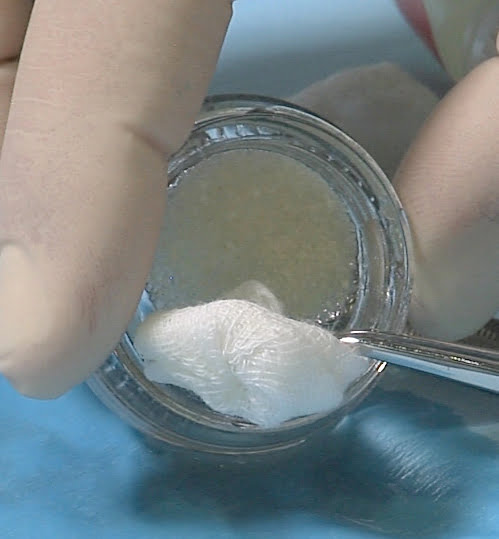
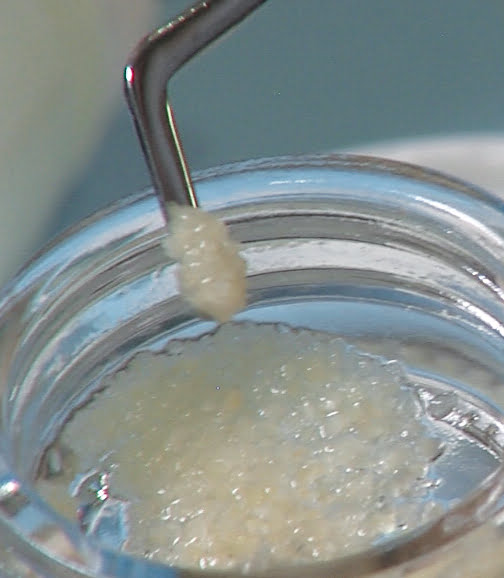
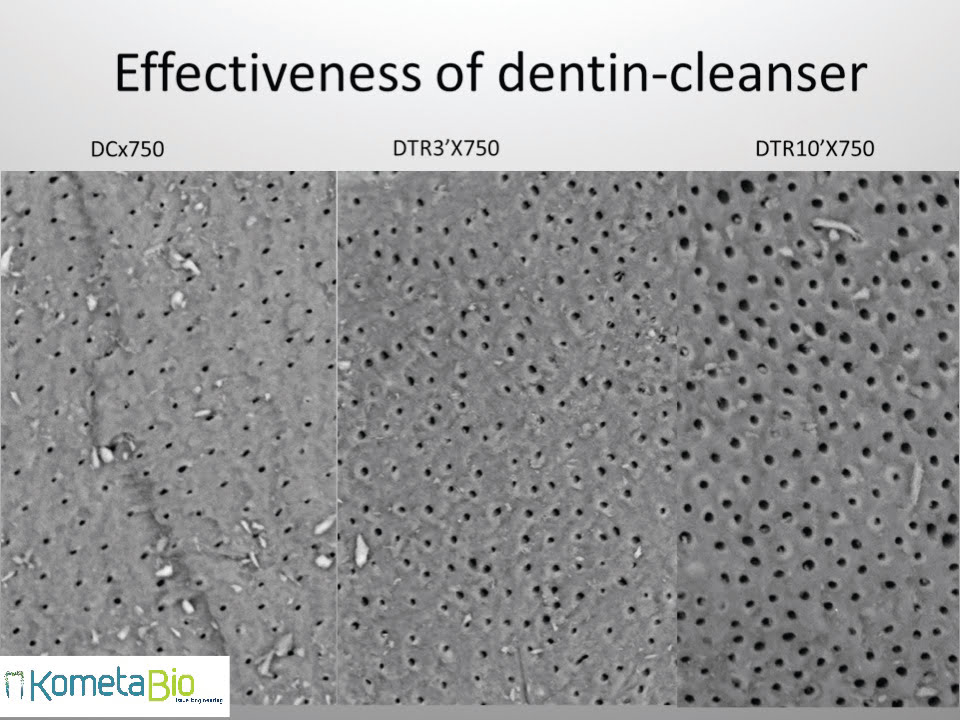
Figures 9-11: The resulting particulate is carefully dried, before being neutralized in a buffering solution for 3 minutes and then again dried with sterile swabs. A third optional stage, involving the use of EDTA solution for 1 minute, can be added between cleansing and neutralizing if so desired. After the tooth has been ground and processed, the resulting “sticky bone” can be used as graft in the alveolus. In practice, the graft does not crumble and exhibits a capacity to bond. A membrane and sutures do not seem to be necessary when patients are advised not to drink, rinse, or brush their teeth for 2½ hours after the procedure
Conclusion and economic considerations
The general dentist during the treatment of his/her patients will typically extract teeth that cannot be preserved and go on to fit a prosthesis of some description. As clinicians, we know that tackling an alveolar resorption rate of around 50% after extraction requires an efficient, non-traumatic treatment that can be carried out chairside and without a big investment in laboratory material.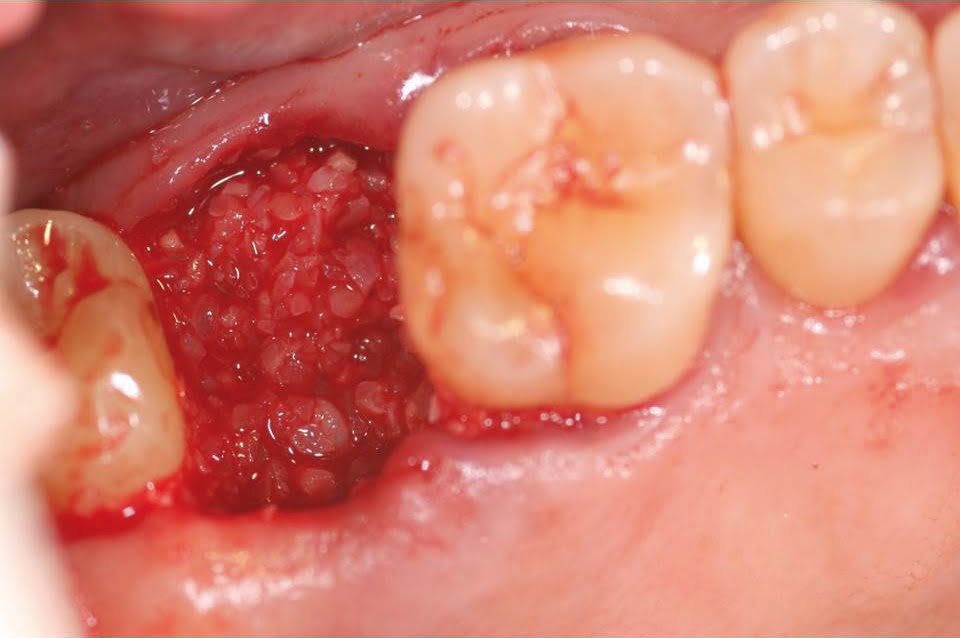
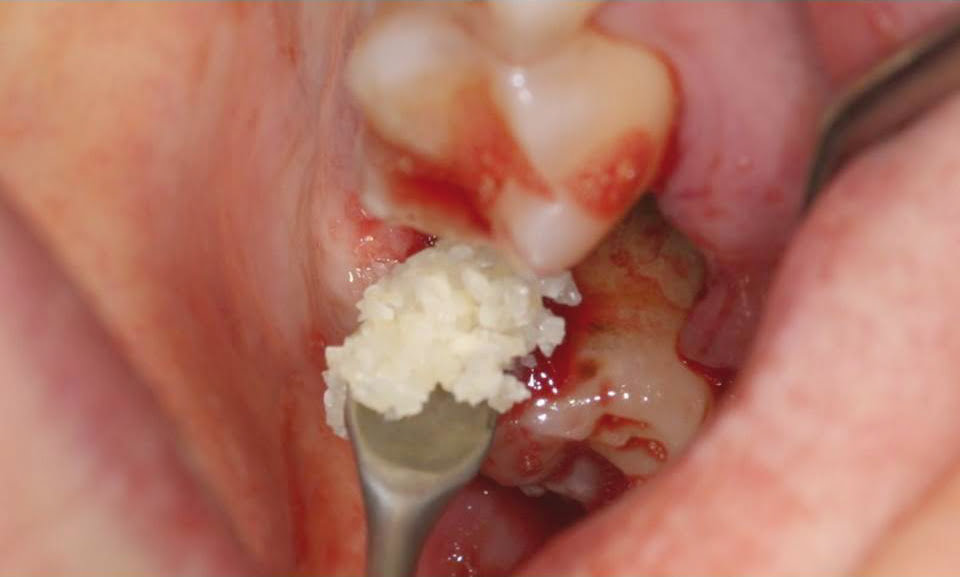
Figures 12 and 13: The resulting “sticky bone” can be used as a grafting material
In the author’s opinion, the Smart Dentin Grinder device, which has been validated by the EC and approved by FDA 510(k) in the U.S., fits this bill. In Europe, the machine is distributed by Champions Implants, a company whose philosophy is that non-traumatic, reliable treatment, requiring fewer surgery sessions should be a priority. With a Smart Dentin Grinder, grafting treatment is quick, efficient, reliable — and also affordable.
From an economical point of view, compared to “classical” socket preservation that uses bovine or alloplastic material, the cost of a chairside procedure using the patient’s own teeth is significantly lower. This author suggests that all clinical colleagues should look at the potential afforded by no longer discarding extracted teeth from the patient. Instead, implant dentists can reuse them as bone graft material, inform their patients about it, and simplify their socket preservation techniques.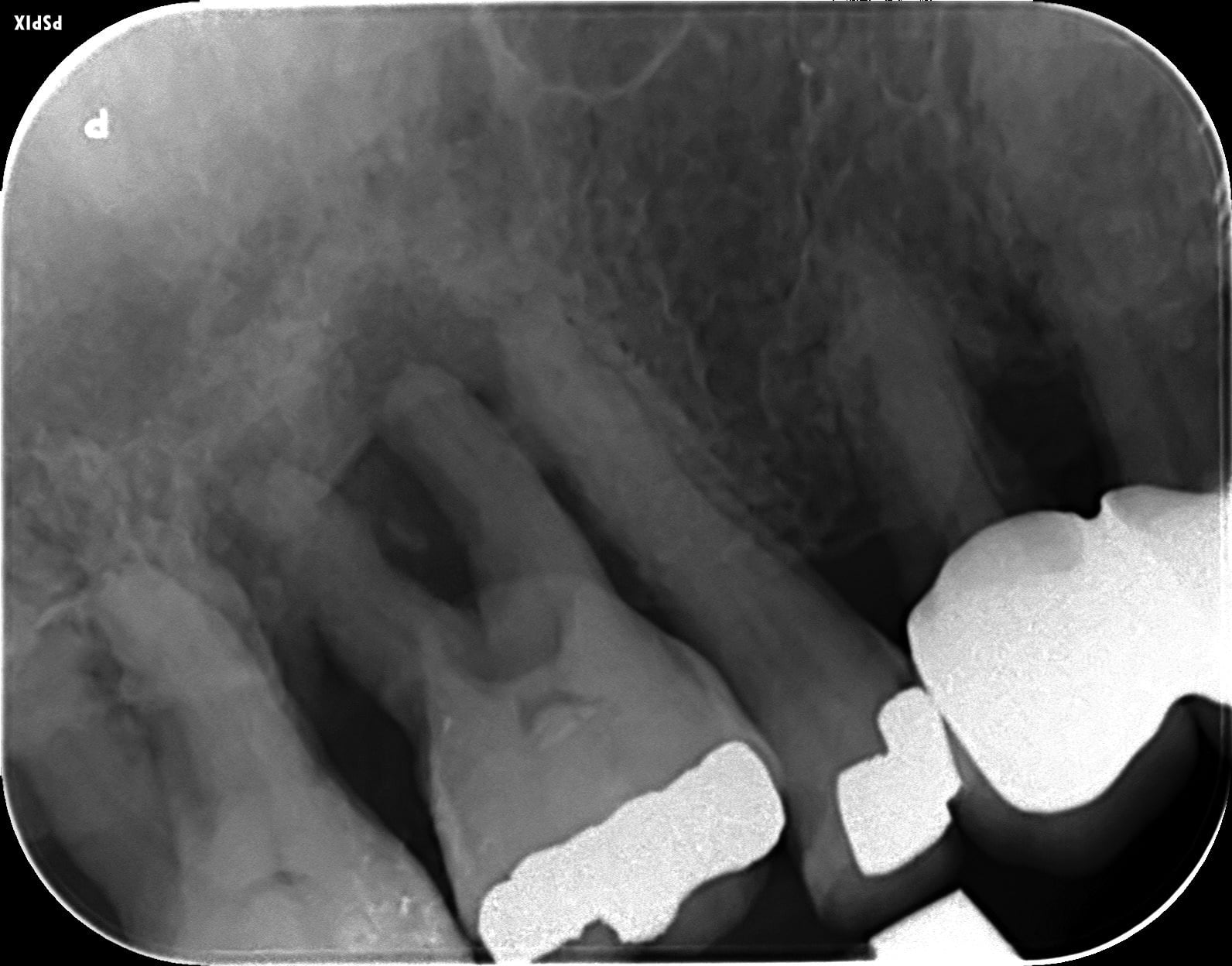

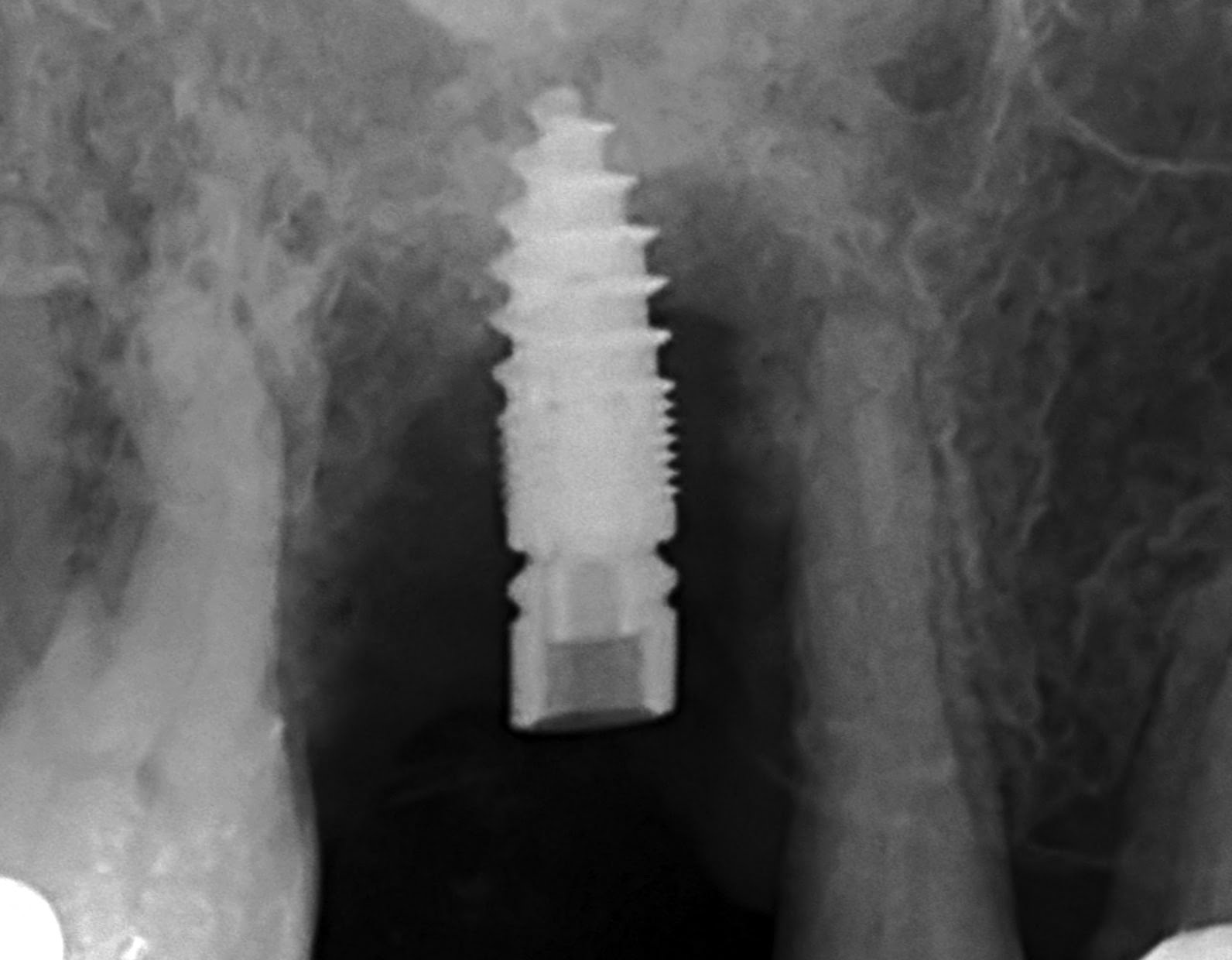
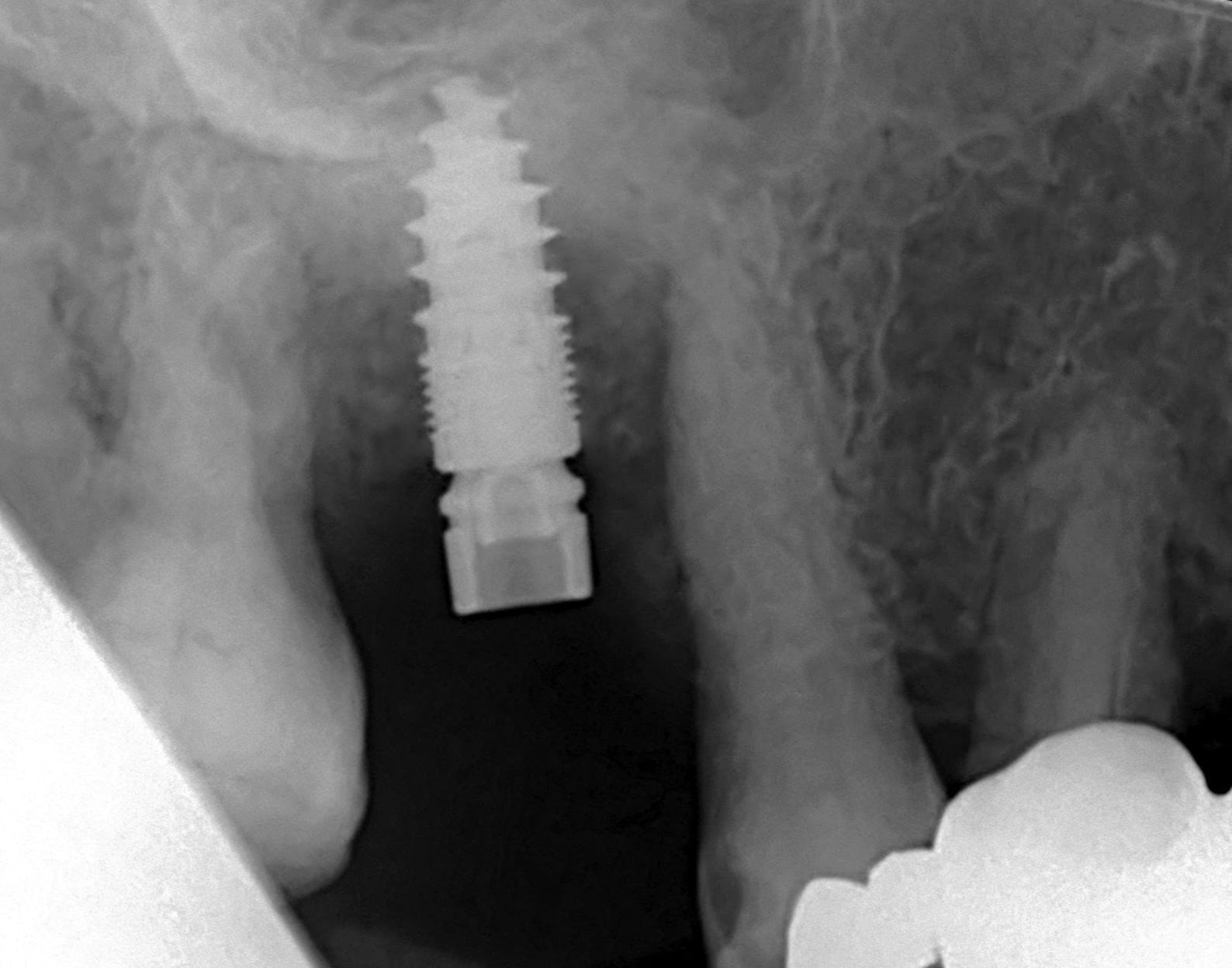
Figures 14-17: The tooth at UR6 could not be preserved (Figure 14). After antibiotic treatment, it was extracted. During immediate implant placement of a Champions (R)Evolution 10×4-mm implant, the tooth was cleaned and prepared. After placing the implant at a primary stability of 30 Ncm (Figure 13), the particulate was placed in the alveolus (Figure 14). After only 10 weeks, very satisfactory results were achieved (Figure 15) with the autologous graft using the Champions Smart Grinder Concept, also in combination with immediate implantation or during an efficient and cost-efficient socket preservation. Additionally, the distal bone at UR5 seemed to regenerate well
References
- Anitua E, Alkhraist MH, Piñas L, Begoña L, Orive G. Implant survival and crestal bone loss around extra-short implants supporting a fixed denture: the effect of crown height space, crown-to-implant ratio, and offset placement of the prosthesis. Int J Oral Maxillofac Implants. 2014;29(3):682-689.
- Arora H, Ivanovski S. Correlation between pre-operative buccal bone thickness and soft tissue changes around immediately placed and restored implants in the maxillary anterior region: A 2-year prospective study. Clin Oral Implants Res.2016.
- Bornstein MM, Scarfe WC, Vaughn VM, Jacobs R. Cone beam computed tomography in implant dentistry: a systematic review focusing on guidelines, indications, and radiation dose risks. Int J Oral Maxillofac Implants. 2014; 29(suppl):55-77.
- Bornstein MM, Al-Nawas B, Kuchler U, Tahmaseb A. Consensus statements and recommended clinical procedures regarding contemporary surgical and radiographic techniques in implant dentistry. Int J Oral Maxillofac Implants. 2014;29(suppl):78-82.
- Buser D, Chappuis V, Belser UC, Chen S. Implant placement post extraction in esthetic single tooth sites: when immediate, when early, when late? Periodontol 2000. 2017;73(1):84-102.
- Canullo L, Pellegrini G, Allievi C, Trombelli L, Annibali S, Dellavia C. Soft tissues around long-term platform switching implant restorations: a histological human evaluation. Preliminary results. J Clin Periodontal. 2011;38(1):86-94.
- Chochlidakis KM, Geminiani A, Papaspyridakos P, Singh N, Ercoli C, Chen CJ. Buccal bone thickness around single dental implants in the maxillary esthetic zone. Quintessence Int. 2016;48(4):295-308.
- Cho-Yan Lee J, Mattheos N, Nixon KC, Ivanovski S. Residual periodontal pockets are a risk indicator for peri-implantitis in patients treated for periodontitis. Clin Oral Implants Res. 2012;23(3):325-333.
- de Oliveira-Neto OB, Barbosa FT, de Sousa-Rodrigues CF, de Lima FJ. Quality assessment of systematic reviews regarding immediate placement of dental implants into infected sites: An overview. J Prosthet Dent. 2017;117(5):601-605.
- Derks J, Schaller D, Håkansson J, Wennstrӧm JL, Tomasi C, Berglundh T. Effectiveness of implant therapy analyzed in a Swedish population: prevalence of peri-implantitis. J Dent Res. 2016;95(1):43-49.
- Du Toit J, Gluckman H, Gamil R, Renton T. Implant injury case series and review of the literature part 1: inferior alveolar nerve injury. J Oral Implantol. 2015;41(4):e144-151.
- Khoury F, Khoury C. Chapter 6, Mandibular bone block grafts: Diagnosis, instrumentation, harvesting, techniques and surgical procedures. In: Khoury F, Antoun H, Missika P, eds. Bone Augmentation in Oral Implantology. Quintpub: London; 2007.
- Kuchler U, von Arx T. Horizontal ridge augmentation in conjunction with or prior to implant placement in the anterior maxilla: a systematic review. Int J Oral Maxillofac Implants. 2014;29(suppl):14-24.
- Harris D, Horner K, Grondahl K, et al. EAO guidelines for the use of diagnostic imaging in implant dentistry 2011. A consensus workshop organized by the European Association for Osseointegration at the Medical University of Warsaw. Clin Oral Implants Res. 2012;23(11): 1243-1253.
- Levine RA, Huynh-Ba G, Cochran DL. Soft tissue augmentation procedures for mucogingival defects in esthetic sites. Int J Oral Maxillofac Implants. 2014; 29(suppl):155-185.
- Linkevicius T, Apse P. Biologic width around implants. An evidence-based review. Stomatologija. 2008;10(1):27-35.
- Mazor Z, Lorean A, Mijiritsky E, Levin L. Nasal floor elevation combined with dental implant placement. Clin Oral Implants Res. 2012;14(5):768-771.
- Merheb J, Vercruyssen M, Coucke W, Beckers L, Teughels W, Quirynen M. The fate of buccal bone around dental implants. A 12-month postloading follow-up study. Clin Oral Implants Res. 2017;28(1):103-108.
- Misch CE. (2015) Chapter 21 – Single-Tooth Implant Restoration: Maxillary Anterior and Posterior Regions. Dental Implant Prosthetics (Second Edition). St. Louis: Mosby 499-552
- Moraschini V, Poubel LA, Ferreira VF, Barboza Edos S. Evaluation of survival and success rates of dental implants reported in longitudinal studies with a follow-up period of at least 10 years: a systematic review. Int J Oral Maxillofac Surg. 2015;44(3):377-388.
- Nunes LS, Bornstein MM, Sendi P, Buser D. Anatomical characteristics and dimensions of edentulous sites in the posterior maxillae of patients referred for implant therapy. Int J Periodontics Restorative Dent. 2013; 33(3):337-345.
- Pohl V, Schuh C, Fischer MB, Haas R. A New Method Using Autogenous Impacted Third Molars for Sinus Augmentation to Enhance Implant Treatment: Case Series with Preliminary Results of an Open, Prospective Longitudinal Study. Int J Oral Maxillofac Implants. 2016;31(3):622-30.
- Puisys A, Linkevicius T. The influence of mucosal tissue thickening on crestal bone stability around bone-level implants. A prospective controlled clinical trial. Clin Oral Implants Res. 2015;26(2):123-129.
- Sanz M, Donos N, Alcoforado G, et al. Therapeutic concepts and methods for improving dental implant outcomes. Summary and consensus statements. The 4th EAO Consensus Conference 2015. Clin Oral Implants Res. 2015;26(suppl 11):202-206.
- Slagter KW, Meijer HJ, Bakker NA, Vissink A, Raghoebar GM. Immediate Single-Tooth Implant Placement in Bony Defects in the Esthetic Zone: A 1-Year Randomized Controlled Trial. J Periodontol. 2016;87(6):619-629.
- Slagter KW, Raghoebar GM, Bakker NA, Vissink A, Meijer HJ. Buccal bone thickness at dental implants in the aesthetic zone: A 1-year follow-up cone beam computed tomography study. J Craniomaxillofac Surg. 2017;45(1):13-19.
- Tahmaseb A, Wismeijer D, Coucke W, Derksen W. Computer technology applications in surgical implant dentistry: a systematic review. Int J Oral Maxillofac Implants. 2014;29(suppl):25-42.
- Tarnow DP. Increasing Prevalence of Peri-implantitis: How Will We Manage? J Dent Res. 2016; 95(1):7-8.
- Thalji G, Al-Tarawneh S. Prosthodontic considerations in the implant restoration of the esthetic zone. In: Sadowsky S, ed. Evidence-based Implant Treatment Planning and Clinical Protocols. Iowa: John Wiley & Sons; 2016.
- Thoma DS, Zeltner M, Hilbe M, Hammerle CH, Husler J, Jung RE. Randomized controlled clinical study evaluating effectiveness and safety of a volume-stable collagen matrix compared to autogenous connective tissue grafts for soft tissue augmentation at implant sites. J Clin Periodontol. 2016;43(10):874-885.
- Urban IA, Jovanovic SA, Lozada JL. Vertical ridge augmentation using guided bone regeneration (GBR) in three clinical scenarios prior to implant placement: a retrospective study of 35 patients 12 to 72 months after loading. Int J Oral Maxillofac Implants. 2009;24(3):502-510.



